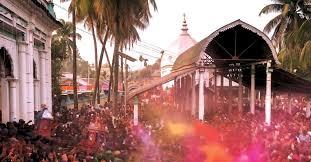History & Traditions
Held annually during the full moon of Phalguna (February–March), Doul Utsav lasts for three to five days and attracts thousands of devotees and travelers. The festival is dedicated to Lord Krishna, affectionately known as “Kalia Gosain,” who is worshipped with great devotion through music, dance, and rituals that reflect the pure essence of Bhakti. Barpeta Satra, also called “Ditiya Vaikuntha” (Second Heaven), transforms into a center of divine celebration, with the air filled with chants, drums, cymbals, and the soulful sound of Holigeet.
The festival is divided into two main types – “Burha Doul” (three-day celebration) and “Deka Doul” (four or five-day celebration). Each day carries unique religious and cultural significance. The first day, known as “Gandha” or “Banhutsava,” marks the beginning of festivities when devotees bring bamboo, khagari, and ekara for the sacred “Meji.” In the evening, Mahaprabhu Doul Govinda and Kalia Thakur are brought out in a colorful procession accompanied by gayan-bayan (traditional musicians). Fireworks, joyous dances, and devotional singing fill the air as the Meji is lit, symbolizing the departure of winter and the welcome of spring.
The second day, called “Bhar Doul,” is marked by Naam-Prasanga, Ojapali performances, and Dhuliya Nritya – a traditional dance that mesmerizes the audience with its rhythm and devotion. On the final day, known as “Phakua” or “Suweri,” Mahaprabhu is brought out in a grand procession, and devotees joyously play with colors, spreading love and unity. The streets of Barpeta come alive with echoes of Holigeets – devotional songs in praise of Lord Krishna. These songs are unique to the Barpeta Satra and carry messages of divine love, harmony, and joy.
A remarkable aspect of Doul Utsav is its theatrical depiction of divine episodes, such as Lord Krishna’s return to Lakshmi after visiting Ghunucha, symbolizing the triumph of love and devotion. This blend of mythology, music, and social participation makes Doul Utsav not just a festival but a way of life in Barpeta. It also strengthens the cultural identity of Assam, emphasizing values like community bonding, equality, and faith.
Over the years, Doul Utsav has gained recognition beyond Assam’s borders. Tourists and researchers from across India and abroad visit Barpeta to witness this rare fusion of spirituality and festivity. The festival’s serene and disciplined approach to Holi, unlike the chaotic celebrations elsewhere, reflects the state’s deep spiritual roots and devotion to Srimanta Sankardeva’s Vaishnavite philosophy.
The Doul Yatra of Barpeta is more than a celebration of color—it is a celebration of divine love, music, and human connection. It stands as a reminder that joy can be spiritual, that unity can be expressed through devotion, and that colors can be the language of the soul. For anyone visiting Assam, witnessing Doul Utsav at Barpeta Satra is a once-in-a-lifetime experience that offers both cultural insight and inner peace.
Quick Info Table - Doul Utsav (Doul Yatra) Barpeta
| Category | Details |
|---|---|
| Festival Name | Doul Utsav or Doul Yatra |
| Location | Barpeta Naamghar, Barpeta, Assam |
| Type of Festival | Vaishnavite religious & cultural festival |
| Main Deity | Lord Krishna (Kalia Gosain) |
| Duration | 3 to 5 days (Burha Doul & Deka Doul) |
| Time of Celebration | Phalguna Purnima (February–March) |
| Main Attractions | Procession of Mahaprabhu, Holigeet, Naam-Prasanga, Sattriya dance |
| Cultural Significance | Promotes unity, devotion, and Vaishnavite heritage |
| Started By | Mathura Das Burha Ata following Srimanta Sankardeva’s teachings |
| Visitors | Devotees, cultural enthusiasts, and travelers from India and abroad |
Doul Utsav (Doul Yatra) Barpeta FAQs
- What is Doul Utsav in Assam?Doul Utsav, or Doul Yatra, is Assam’s version of Holi, celebrated at Barpeta Naamghar with devotion, colors, and traditional music.
Where is Doul Utsav celebrated?
The festival is celebrated at Barpeta Satra, one of Assam’s most prominent Vaishnavite monasteries.Who started Doul Utsav in Barpeta?
Doul Utsav was first celebrated by Mathura Das Burha Ata following Srimanta Sankardeva’s Vaishnavite traditions.When does Doul Utsav take place?
It is held during Phalguna Purnima (February–March), marking the arrival of spring.How many days is Doul Utsav celebrated?
The festival lasts 3–5 days, known as “Burha Doul” or “Deka Doul.”What are the main attractions of Doul Utsav?
Holigeet singing, Naam-Prasanga, Dhuliya Nritya, fireworks, and the grand palanquin procession of Lord Krishna.What is the difference between Doul Utsav and Holi?
Doul Utsav is a devotional and disciplined celebration focusing on spirituality, unlike the playful Holi seen elsewhere.What music is associated with Doul Utsav?
Traditional Holigeets and Naam-Prasanga sung in praise of Lord Krishna.What is the cultural significance of Doul Utsav?
It reflects Assam’s Vaishnavite heritage, promoting love, equality, and devotion.Why should travelers visit Barpeta during Doul Utsav?
It offers a unique blend of spirituality, tradition, and festive joy, making it a must-see cultural experience in Assam.
